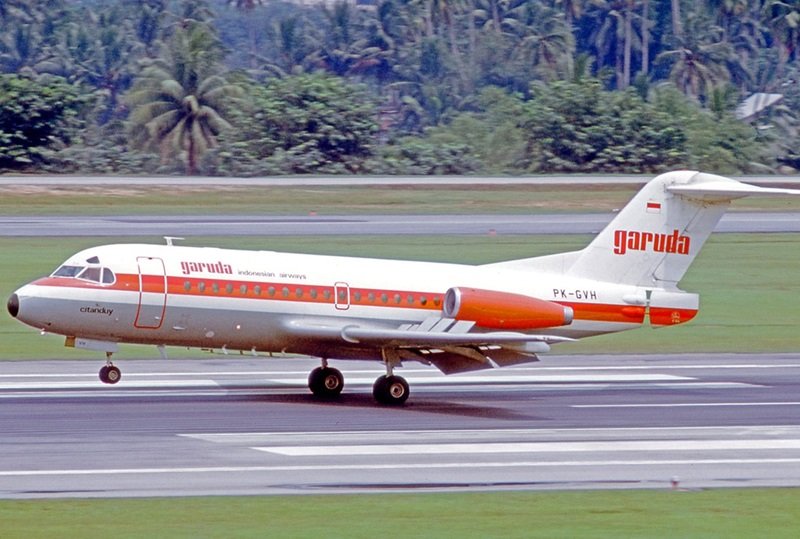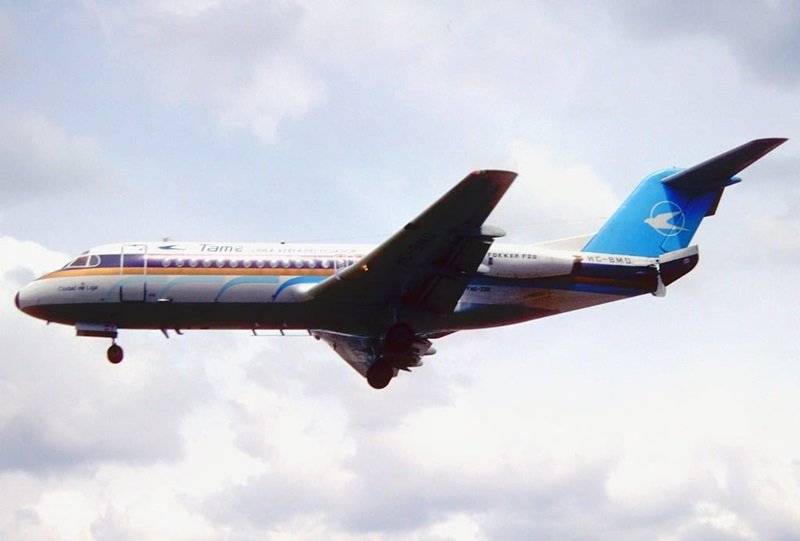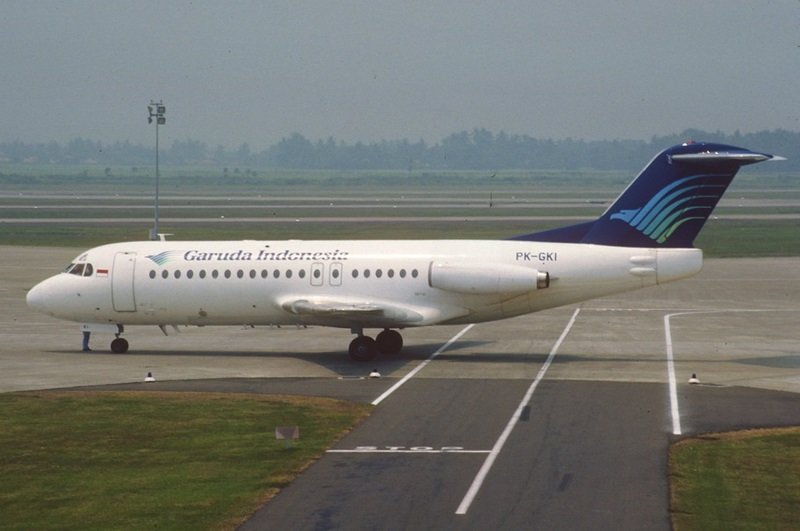
Fokker F28 Fellowship.
HISTORY
ORDERS
SPECS
ASSEMBLY
NLM CityHopper Fokker F28-4000 at Amsterdam registration PH-CHF named Guernsey.
The Fokker F28 was a low-wing airliner with twin engines located on each side of the rear of the fuselage. With a T-tail and tricycle undercarriage, the F28 was designed to complement the already successful turboprop, the Fokker F27 Friendship.
So what was the Fokker F-28 Fellowship like? She was around the same size as the four-engined turboprop Vickers Viscount a popular airliner of the day, but faster. The F28 was slower than other jets, but Fokker intended the aircraft to be simple as well as to be able to service around 85% of the airfields that the F27 and Douglas DC3 were able to.
Tame Fokker F28 Fellowship registration HC-BMD with tail cone Speed brake deployed.
As mentioned above, the aircraft featured a T-tail with rear-mounted twin engines. To look at, she wasn't too dissimilar to the early Douglas DC-9 or the BAC-111.
The low main wing had a slight crescent angle of sweep and sported a simple flap system. The outboard ailerons also worked in unison with the flaps when these were deployed.
The lift dumpers or spoilers were in five sections and could only be deployed on the ground to aid in braking. These replaced any reverse thrust provided by the engines, a feature that was left out to aid in simplicity, weight reduction, and avoidance of debris being kicked up on unprepared strips.
Flight West Airlines Fokker F28 Fellowship-4000 registration VH-EWC at Cairns (CNS) 02OCT1999.
As Fokker was intending this airliner to be able to operate from unprepared airstrips it was felt that reverse thrust would also not be suitable in these conditions as there was a risk of damaging debris being thrown up into the aircraft. The aircraft was, however, fitted with antiskid brakes which went a long way to enabling good short-field stopping.
As well, the fitting of larger low-pressure tyres enabled the aircraft to operate more effectively on unprepared airstrips.
Leading-edge slats were also not a feature on the main wing of the F28, once again to maintain the simplicity of the aircraft. De-icing was achieved by using bleed air from the engines.
Tame Fokker F28 Fellowship 4000 registration HC-BZU Mariscal Sucre International Airport Quito (UIO).
A unique feature that Fokker added to the F28 was the hydraulically operated tail air brake. This feature, which was later also used on the BAe 146/Avro RJ almost 20 years later, consisted of the two halves of the tail cone opening up to increase drag. This braking system could be used in flight, as opposed to the lift dumpers on the wing which we have mentioned can only be deployed on the ground.
There were several advantages to this system as it could quickly enable the F28 to descend from its optimal cruise altitudes to lower altitudes more quickly. It also enabled the F28 to keep its engines running at a higher rate in critical phases of flight, like an approach to an airfield. This reduced any lag time in the engines spooling up should power suddenly be required in the case of a go-round.
The production of the Fokker F28 was achieved by a collaboration of four main players. They were Fokker themselves, as well as West German companies, Messerschmitt-Bölkow-Blohm (MBB) and VFW-Fokker, and Northern Ireland company Short Brothers. The Netherlands government funded 50% of the Fokker share and the West German government funded 65% of the West German share of the production. The companies were responsible for the various parts of the F28 as follows:
Fokker - nose section, centre fuselage and inner wing.
MBB/Fokker VWF - forward fuselage, rear fuselage and tail assembly.
Shorts - outer wings.
The final assembly was completed at Amsterdam's Schiphol Airport.
ASSEMBLY
Aero Continente Fokker F28 Fellowship 1000 registration OB-1636.
SPECIFICATIONS
Fokker F28 Fellowship Specs Table
| Fokker F28 | -1000 | -2000 | -3000 | -4000 |
|---|---|---|---|---|
| Crew | 2 | |||
| First Flight | 24 February 1969 | 28 April 1971 | 19 July 1978 | 20 October 1976 |
| Number Produced | 97 | 10 | 22 | 112 |
| Passengers | 65 | 79 | 65 | 85 |
| Cabin Width(Internal) | 3.1m (11ft 1in) | |||
| Aircraft Length | 27.4m (89ft 10in) | 29.6m (97ft 2in) | 27.4m (89ft 10in) | 29.6m (97ft 2in) |
| Tail Height | 8.47m (27 ft 9.5 in) | |||
| Main Wing Span | 23.6m (77ft 4in) | 23.6m (77ft 4in) | 25.7m (82ft 3in) | 25.7m (82ft 3in) |
| Main Wing Area | 76.4m2 (822ft2) 16˚ Sweep, Aspect Ratio(AR) 7.3:1 |
79m2 (850ft2) 16˚ Sweep, Aspect Ratio(AR) 8:1 |
||
| Empty Weight | 16,144 kg (35,517 lb) | 16,707 kg (36,953 lb) | 16,846 kg (37,139 lb) | 17,611 kg (38,825 lb) |
| MTOW | 29,480 kg (65,000 lb) | 33,110 kg (73,000 lb) | ||
| Maximum Payload | 8,629 kg (18,983 lb) | 7,976 kg (17,547 lb) | 8,620 kg (19,003 lb) | 10,556 kg (23,307 lb) |
| Takeoff Dist.(MTOW) | 1,676 m (5,500 ft) | |||
| Landing Distance | 1,079 m (3,540 ft) | 967 m (3,173 ft) | 1,065 m (3,495 ft) | |
| Fuel Capacity | 13,040 L (2,869 imp gal; 3,445 US gal) | |||
| Engines x 2 | Rolls-Royce Spey Mk 555-15 | Rolls-Royce Spey Mk 555-15H | ||
| Engine Thrust x 2 | 43.9 kN (9,850 lbf) | |||
| Speed (Max Cruise) | 458kn, 527mph, 848kph | 436kn, 502mph, 808kph | ||
| Service Ceiling | 35,000 feet (10,670 metres) | |||
| Range Fully Laden | 1,705km, 920nm | 2,872km, 1,550nm | 1,668km, 900nm | |
History.
Garuda Indonesia Fokker F28 Fellowship 4000 registration PK-GKI. Garuda Indonesia was the largest operator of the F28 with 62 aircraft in its fleet at one time.
Fokker, the Netherlands aircraft maker with a rich history going back to 1912, had been enjoying great success with their twin turbo-prop commuter, the F-27 Friendship.
In the early 1960s, Fokker felt that the market was ready for a small jet commuter airliner. Perhaps this was spurred on by British European Airways (BEA) releasing their requirement for a high-speed turbojet regional airliner in 1960. Spending much time and resources on researching the market, they announced the new F28 in April 1962.
Their research included seeking feedback from customers, particularly North American customers as they wanted the aircraft to have the commonality of language and other considerations to ensure it was internationally palatable.
Initially, Fokker was considering a 50-seat capacity aircraft, but their market research determined that a 65-seater would be a much more saleable product. Development of the prototype went ahead and the first flight of this F28-1000 prototype took place on 09 May 1967. In command was Chief Test Pilot Jas Moll with Co-Test Pilot Abe van der Schraaf and flight engineer Cees Dik.
A Braathens SAFE Fokker F-28-1000 registration LN-SUC.
Flight testing of the new airliner was conducted until the West German certification of the type was granted on 24 February 1969.
Although the first order had been placed by West German carrier LTU, the first commercial flight of the Fokker F-28 was actually flown by Swedish carrier Braathens SAFE on 28 March 1969.
On 28 April 1971, the first new variant of the F28 flew, the F28-2000. This was a stretched version of the F28-1000. The same prototype for the 1000 was actually converted to the 2000 specifications to complete certification.
Fokker also came up with an F28-5000 which was an updated version of the F28-1000 and an F28-6000 which was an update of the F28-2000. These updated variants featured wing slats, greater wingspan and more powerful quieter engines.
Neither version met with any success. Two 6000s were built and no 5000s.
Linjeflyg F28-4000 registration SE-DGI at Jersey.
The most successful variant of the Fokker F28, the F28-4000 first flew on 20 October 1976 and entered service with Swedish domestic carrier, Linjeflyg. The 4000 could carry 85 passengers which was made possible by a larger wingspan with more reinforcement to those wings, as well as the newer Spey 555-15H engines.
Production of the Fokker 28 Fellowship ran from 1967 to 1987. Over 20 years of production of the F28 Fokker produced 241 airframes. The type was superseded by the new Fokker F100 and later the smaller Fokker F70.
In addition, Fairchild Aircraft of the U.S.A. developed the Fairchild 228 based on the F28 for the U.S. market. Only two were ever built as there was a hold-up of certification due to the uncertainty around the Rolls Royce Trent RB203 engine performance. The delay effectively drove Fairchild to announce the termination of the program. US$30M of development costs had to be written off.














